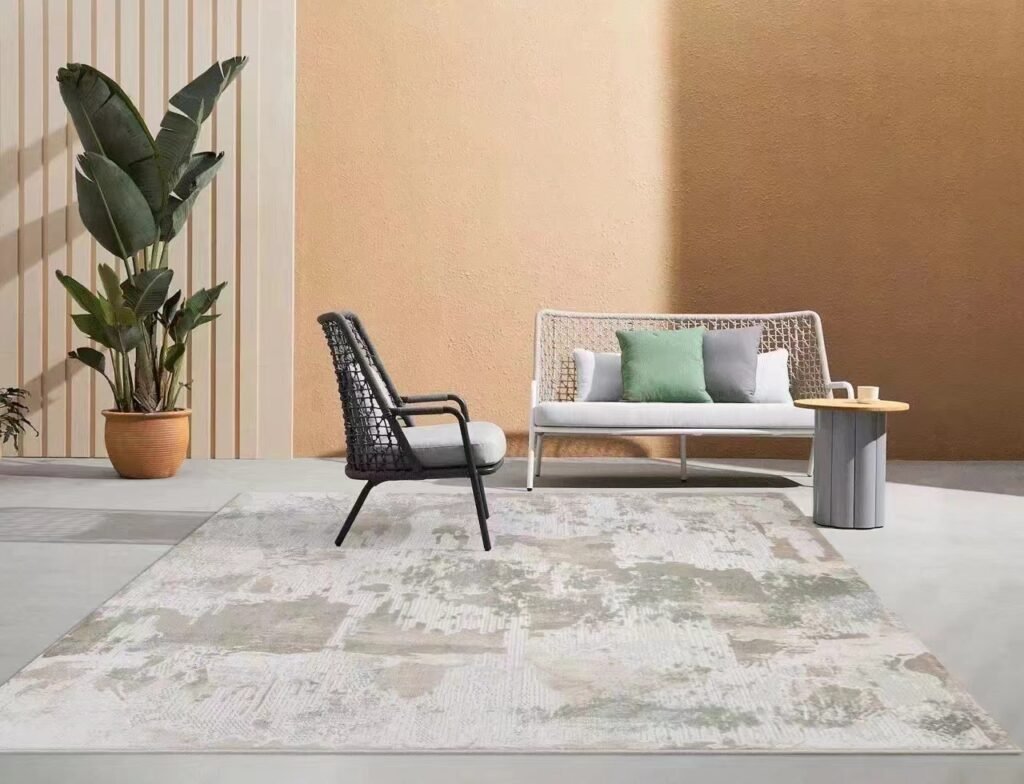Characteristics of Area Rugs Different Materials
Area rugs are crafted from a variety of materials, each possessing unique characteristics that influence their performance, appearance, and suitability for different spaces within the home. Understanding the distinctive traits of these materials is crucial for selecting the right rug that aligns with your aesthetic preferences, lifestyle, and practical needs. Let’s delve deeper into the characteristics of different materials used in area rugs:


Natural Fibers:
Natural fibers, sourced from plants or animals, offer a timeless appeal and luxurious feel to area rugs. Among the most commonly used natural fibers are wool, cotton, and silk.
Wool:
Wool rugs are renowned for their exceptional durability, softness, and resilience, making them a popular choice for both traditional and modern interiors. Wool fibers possess inherent elasticity, allowing them to withstand heavy foot traffic without losing their shape or appearance. Additionally, wool is naturally flame-resistant, making it a safer option for households with children or pets. Its insulating properties help regulate room temperature by trapping heat during colder months and providing a cool surface during warmer seasons. While wool rugs may require regular maintenance to prevent shedding and maintain their appearance, their longevity and timeless appeal make them a worthwhile investment for any home.
Cotton:
Cotton rugs are prized for their affordability, versatility, and ease of care. These lightweight rugs offer a casual and relaxed aesthetic, making them ideal for laid-back living spaces such as kitchens, dining rooms, and bedrooms. Cotton fibers are highly absorbent, making cotton rugs an excellent choice for areas prone to spills or moisture, as they can be easily spot cleaned or machine washed. However, cotton rugs may lack the durability and longevity of wool rugs, and they may flatten over time with heavy use. Nevertheless, their soft texture, vibrant colors, and budget-friendly price point make them a popular option for homeowners seeking a practical and stylish flooring solution.
Silk:
Silk rugs epitomize luxury and sophistication, with their smooth texture, luminous sheen, and intricate designs. Sourced from silkworm cocoons, silk fibers are exceptionally fine and delicate, creating rugs that exude opulence and elegance. Silk rugs are prized for their ability to reflect light, adding a sense of depth and dimension to any room. However, due to their delicate nature, silk rugs require gentle care and maintenance to preserve their beauty. They are best suited for low-traffic areas such as formal living rooms or master bedrooms, where they can be admired for their exquisite craftsmanship and artisanal quality.
Synthetic Fibers:
Synthetic fibers are man-made materials engineered to mimic the look and feel of natural fibers while offering enhanced durability, stain resistance, and affordability. Common synthetic fibers used in area rugs include nylon, polyester, and polypropylene.
Nylon:
Nylon rugs are prized for their exceptional durability, resilience, and versatility, making them an ideal choice for high-traffic areas such as entryways, hallways, and family rooms. Nylon fibers are inherently resistant to stains, fading, and abrasion, ensuring that these rugs maintain their appearance and performance even in the most demanding environments. Additionally, nylon rugs are easy to clean and maintain, requiring minimal effort to remove dirt, spills, or pet stains. With a wide range of colors, patterns, and textures available, nylon rugs offer homeowners endless design possibilities to suit their personal style and aesthetic preferences.
Polyester:
Polyester rugs are celebrated for their vibrant colors, soft texture, and budget-friendly price point, making them a popular choice for homeowners seeking an affordable yet stylish flooring option. Polyester fibers are naturally resistant to moisture, mold, and mildew, making these rugs suitable for humid environments such as bathrooms or basements. Additionally, polyester rugs are fade-resistant, ensuring that their colors remain vibrant and true over time. While polyester rugs may not offer the same level of durability as nylon or wool rugs, they provide a plush and inviting surface that adds warmth and comfort to any room.
Polypropylene:
Polypropylene, also known as olefin, is a versatile synthetic fiber prized for its durability, stain resistance, and affordability. Polypropylene rugs are highly resistant to moisture, making them ideal for outdoor use or areas prone to spills or humidity. These rugs are easy to clean and maintain, as polypropylene fibers repel dirt and stains, allowing for quick and effortless spot cleaning. Additionally, polypropylene rugs are fade-resistant, ensuring that their colors remain vibrant and true even when exposed to sunlight or harsh weather conditions. With their wide range of designs and patterns available, polypropylene rugs offer homeowners a practical and stylish flooring solution for any space.
Blends:
Blended rugs combine the best qualities of natural and synthetic fibers, offering a balance of durability, softness, and affordability. Common blends include wool-synthetic blends and cotton-synthetic blends.
Wool-Synthetic Blend:
Wool-synthetic blend rugs combine the luxurious feel of wool with the enhanced durability and stain resistance of synthetic fibers. These rugs offer the best of both worlds, providing softness, resilience, and easy maintenance. Wool-synthetic blend rugs are suitable for a variety of spaces within the home, from formal living rooms to high-traffic areas such as hallways or staircases. With their versatile design options and long-lasting performance, wool-synthetic blend rugs offer homeowners a practical and stylish flooring solution that withstands the test of time.
Cotton-Synthetic Blend:
Cotton-synthetic blend rugs combine the softness and breathability of cotton with the enhanced durability and stain resistance of synthetic fibers. These rugs are lightweight, easy to clean, and budget-friendly, making them a practical choice for casual living spaces or children’s rooms. Cotton-synthetic blend rugs are available in a variety of colors, patterns, and textures, allowing homeowners to customize their flooring to suit their personal style and aesthetic preferences. With their blend of natural and synthetic fibers, these rugs offer a versatile and affordable flooring solution that complements any interior design scheme.
Conclusion:
In conclusion, the characteristics of different materials used in area rugs play a crucial role in determining their performance, appearance, and suitability for various spaces within the home. Whether crafted from natural fibers such as wool, cotton, and silk, or synthetic fibers like nylon, polyester, and polypropylene, each material offers its own unique advantages and considerations. By understanding the distinctive traits of these materials, homeowners can make informed decisions when selecting the perfect rug to enhance their living spaces. From durability and softness to stain resistance and affordability, the right area rug can truly weave comfort, style, and functionality into every room.




